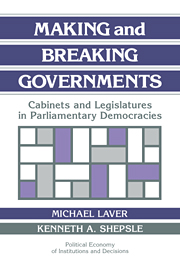Book contents
- Frontmatter
- Contents
- Series editors' preface
- Acknowledgments
- PART I THE CONTEXT
- 1 Theory, institutions, and government formation
- 2 The social context of government formation
- 3 The government formation process
- PART II THE MODEL
- PART III EMPIRICAL INVESTIGATIONS
- PART IV APPLICATIONS, EXTENSIONS, AND CONCLUSIONS
- References
- Index
3 - The government formation process
Published online by Cambridge University Press: 06 January 2010
- Frontmatter
- Contents
- Series editors' preface
- Acknowledgments
- PART I THE CONTEXT
- 1 Theory, institutions, and government formation
- 2 The social context of government formation
- 3 The government formation process
- PART II THE MODEL
- PART III EMPIRICAL INVESTIGATIONS
- PART IV APPLICATIONS, EXTENSIONS, AND CONCLUSIONS
- References
- Index
Summary
Having outlined our assumptions about how political actors view the making and breaking of governments, we now roll up our sleeves and move on to the process itself. Here we begin to assemble the raw materials out of which we will build a model. Obviously, once we get down to the nitty-gritty of how things are actually done in the real world, we find that governments are formed according to different rules and procedures in each parliamentary democracy. Any one of these differences is potentially of great importance in some particular circumstance. There are considerable broad similarities in the rules that structure government formation, however – sufficient to allow us to model a “generic” government formation procedure that can, with modest amendments, be adapted to most particular government formation situations.
First, since our rational foresight approach assumes that sophisticated political actors take account of, and adjust to, events that they can foresee in the future, we must specify what it is that triggers the government formation process in the first place. Second, we must be clear about the status quo that determines policy outputs if attempts to make a new government, or break an incumbent one, are unsuccessful. Third, we must provide a stylized description of the process that is triggered. Fourth, we must transform our stylized description into a model. Finally, we must explore implications of our model for the making and breaking of governments.
TRIGGERING THE GOVERNMENT FORMATION PROCESS
The process of government formation can be triggered in several different ways. These include an election, a government defeat in the legislature, or a government resignation.
- Type
- Chapter
- Information
- Making and Breaking GovernmentsCabinets and Legislatures in Parliamentary Democracies, pp. 43 - 58Publisher: Cambridge University PressPrint publication year: 1996

